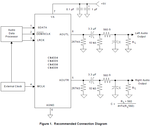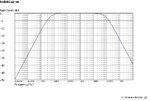matrixofdynamism
Advanced Member level 2
The CS4334 is an Audio DAC. It already has internal on chip filtering and interpolation capabilities as clear from datasheet page 12 Figure 8. I assume that this means that no filter is require to remove the high frequency components that are typical of outputs on DACs. However, the recommended connection diagram on page 4 Figure 1 of the datasheet looks like this:

Questions
(1) Why are there networks of resistors and capacitors at the output?
(2) Why is load shown as resistive, should it not be inductive as speakers are represented? If a power amplifier is being used at the output than this makes sense.
(3) Why is there in arrow pointed to right after the RL as if the signal goes beyond the RL?
(3) Why is C dependant on the load? Certainly if we want to get a specific frequency response, we should have fixed values for RC in the high and low pass filters.

Questions
(1) Why are there networks of resistors and capacitors at the output?
(2) Why is load shown as resistive, should it not be inductive as speakers are represented? If a power amplifier is being used at the output than this makes sense.
(3) Why is there in arrow pointed to right after the RL as if the signal goes beyond the RL?
(3) Why is C dependant on the load? Certainly if we want to get a specific frequency response, we should have fixed values for RC in the high and low pass filters.
